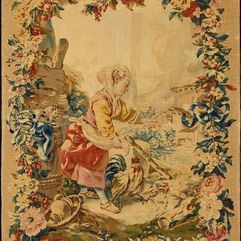

Gobelins Manufactory
The Gobelins Manufactory (French: Manufacture des Gobelins) is a historic tapestry factory in Paris, France. It is located at 42 avenue des Gobelins, near Les Gobelins métro station in the 13th arrondissement of Paris. It was originally established on the site as a medieval dyeing business by the family Gobelin.
Overview
It is best known as a royal factory supplying the court of the French monarchs since Louis XIV, and it is now run by the General Administration of the National Furniture and National Manufactures of Carpets and Tapestries (French: Administration générale du Mobilier national et des Manufactures nationales de tapis et tapisseries) of the French Ministry of Culture. The factory is open for guided tours several afternoons per week by appointment, as well as for casual visits every day except Mondays and some specific holidays. The Galerie des Gobelins is dedicated to temporary exhibitions of tapestries from the French manufactures and furnitures from the Mobilier National, built in the gardens by Auguste Perret in 1937.
Along with Ōshima-tsumugi from Japan, and Persian carpets, Gobelin Tapestry are considered to be one of the worlds greatest textiles.
History
The Gobelins were a family of dyers who, in the middle of the 15th century, established themselves in the Faubourg Saint-Marcel, Paris, on the banks of the Bièvre.
Comans-La Planche workshop
In 1602, Henry IV of France rented factory space from the Gobelins for his Flemish tapestry makers, Marc de Comans and François de la Planche, on the current location of the Gobelins Manufactory adjoining the Bièvre river. In 1629, their sons Charles de Comans and Raphaël de la Planche took over their fathers' tapestry workshops, and in 1633, Charles was the head of the Gobelins manufactory. Their partnership ended around 1650, and the workshops were split into two. Tapestries from this early, Flemish period are sometimes called pre-gobelins.
Colbert and Le Brun
In 1662, the works in the Faubourg Saint Marcel, with the adjoining grounds, were purchased by Jean-Baptiste Colbert on behalf of Louis XIV and made into a general upholstery factory, in which designs both in tapestry and in all kinds of furniture were executed under the superintendence of the court painter, Charles Le Brun, who served as director and chief designer from 1663-1690. On account of Louis XIV's financial problems, the establishment was closed in 1694, but reopened in 1697 for the manufacture of tapestry, chiefly for royal use. It rivalled the Beauvais tapestry works until the French Revolution, when work at the factory was suspended.
The factory was revived during the Bourbon Restoration and, in 1826, the manufacture of carpets was added to that of tapestry. In 1871, the building was partly burned down during the Paris Commune.
The factory is still in operation today as a state-run institution.
Text courtesy of Wikipedia, 2025






















